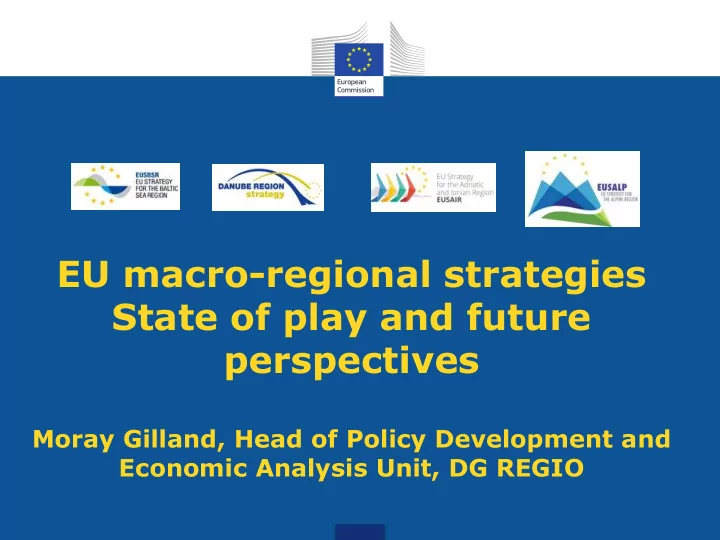

EU macro-regional strategies State of play and future perspectives Moray Gilland, Head of Policy Development and Economic Analysis Unit, DG REGIO
Moving towards post-2020 cohesion policy package White paper on future and launch of inclusive reflection process Closely connected to the preparation of the next Multiannual Financial Framework MFF Cohesion Forum on 26-27 June 2017 Cohesion Report to be published in autumn 2017 Impact Assessment – internal preparations are underway but timing not yet established The adoption of the legislative proposals to follow the MFF proposal
Cohesion policy opened to reform – key investment policy for regions Flexibility : Reconciling need for stable investment framework in the medium term, while remaining responsive to new emerging challenges Performance and the delivery of results : building on the strong focus on results and performance introduced for 2014-2020 (intervention logic, performance framework and reserve) Economic governance/structural reforms : Strengthening the relationship between cohesion policy and economic governance Simplification : Further simplification and a more result- oriented approach
• The success of the delivery of the 2014-2020 programme is the best basis to argue in favour of a strong cohesion policy for the future. • Important to continue to assess and build on results from the existing MRSs.
Report on the implementation of EU macro-regional strategies (MRS) and Council conclusions Implementation of four current macro-regional strategies since 2009 19 EU Member States + 8 non EU countries covering 270 million inhabitants Draw lessons in the light of post-2020 reform
An important opportunity for European cooperation A bottom up approach based on local, regional and national needs An appropriate framework for sectorial EU policies (transport, energy, innovation, environment … ) More ESIF programmes engaging into MRS A way of promoting multi-level governance A new element to take account of when addressing challenges over borders (internal and external).
State of implementation of MRS MRS are at different stages of implementation since 2009 • EUSBSR - a stable cooperation framework (more than 100 flagships and new networks) but needs to keep momentum and to improve policies coordination and content by building on projects results • EUSDR - implementation on track and better culture cooperation but still some issues (decreasing political momentum, issue of administrative capacity in non-EU countries)
State of implementation of MRS • EUSAIR - strong political commitment (cf. Dubrovnik Ministerial Declaration in May 2016) but shortfalls in implementation (human and funding resources) • EUSALP - quick start of actions/initiatives, largely driven by regions. Active participation of countries also required. Given the high expectations, to be very vigilant on keeping the momentum.
How to make better use of MRS potential MRS gradually integrated in policy planning at EU level, but more sporadically at national/regional level. Room for improved coordination within countries Contributions to the MRSs implementation in practice vary significantly across programmes. Need to ensure a closer co- ordination between national and regional cohesion policy programmes and MRSs, synergies with other funding instruments Governance remains the cornerstone of MRS success. More effective governance systems (better internal coordination within and between countries, appropriate administrative support) Robust monitoring system still missing Stronger focus on results (in line with the 2014-2020 cohesion policy period, search for stronger policy impact of the projects) Strong communication strategies needed
MRSs and future cohesion policy What will make the real difference in practice to fully embed the MRSs into cohesion policy programmes: A clearer definition in the EU regulatory framework? Additional provisions in the operational programmes required thus better strategic planning? Enhanced coordination between actors? Closer monitoring of Commission? Stronger result orientation based on relevant indicators (Council Conclusions)? Is it sharing of good practices among the strategies? Should transnational programmes be (functionally) further aligned with MRS or other transnational cooperation frameworks and initiatives? •
MRSs and future cohesion policy MRS is a valuable strategic element in economic development – MS/regions have commitment to deliver Enhancing provisions for cooperation possibilities between programmes (and regions) INTERREG programmes and transnational programmes are well-positioned to contribute to MRSs but should not be the only contributors. How to make policy implementation more flexible , to be able to respond to emerging national and European challenges, also within MRS framework No more “one size fits all” concept for the cohesion policy
Recommend
More recommend